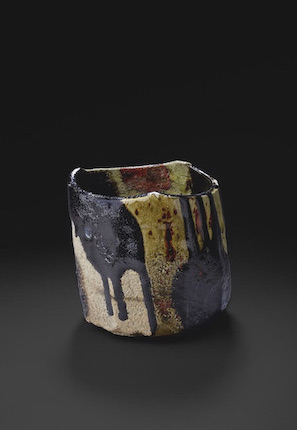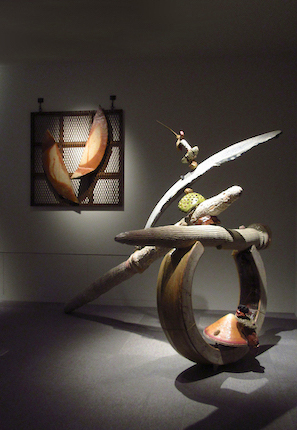
ï]Çñ
¬ìÒq
[©©¡
\ÜãÙg¶åÊå
Bí²ê
HRz
äãëV
Koie Ryoji
Ogawa Machiko
Fukami Sueharu
Raku Kichizaemon XV
Kakurezaki Ryuichi
Akiyama Yo
Inoue Masayuki
Nov.27 fri - Dec.26 sat , 2020
11:00-19:00@closed on Sunday

![ï]Çñu`FmuCv@Koie Ryoji Chernobyl](koie.jpg)

ªüpÌ¢EÉüÁ½ÌÍ1994NBXÌWï}^ÅìêA»µÄlXÈûæèA[pAAMy©|ÌXI[vAuVâvABí²êÌut@NXvWÉÀÑÁÄ£ÁÄÁ½bApOzGg[W̱ÆÈÇ·©³êAÌMCÌ]CÍܾ\ªÉcÁÄ¢½B1995Nð߬½Óè©çAsiCÆÜèAéÉÈÁÄ¢Á½æ¤ÉL¯·éBȸÁÆA»Ì`¦·¢Ä¢½1990N ̱ƪCÉÈÁÄ¢½B
1980Nã©ç1990Nã¼ÎÉ©¯ÄAüpjÆ £R¾ðSƵÄuNC[NvÉÖµÄXÌWïªJÃAìiÍå^»ðàݹAüpÙA¤ÒAW[iYªêÌÆÈèå«È[ugÆÈéB¯ÉA©¥¤Æ Ñ®°Oª»ã©|É[ÖíènßATg[üpÙAüpÙÈÇÅÌWïðå±A1989NÉÍuãðñVµ¢Ì¢`Wvðú{´Ozɨ¢Ä1993NÜÅ5ñJ÷éÈÇAAâåȨÍÅ Á½¹Ìªìɨ¢ÄàAVµ¢WJðݹnßéBܽA1989Nu[pAf89WpvªxM[ÅJóêéB[bpÅåÌ|pÕÅA[bpÈOÌÅßÄAú{ªe[}ÌñÆÈèAÛð¬îàåÃÌàÆuºaÌ©||`ÆvVvªJóêéÈÇAóOÌDiCÆÜÁÄA±¤µ½XÌüpÙÅÌWïAÛWASÝXüpS·ÌãÌSÝXÅÌWïA»êɺ¤½Ì}^AGÌÁWAØìiWÌoÅXB
±Ìæ¤ÈNCEbV ÆàÄ×é1990NOãÌãóµA»ñÈA»ê¼êÌWJðݹ½A7lÌìÆðæèã°u1990 Clay Rush vÆèµAWïðJÃvµÜ·B
7lÌìÆ̤¿Aê¢ããÅ éï]ÇñÍA±ÌãðÛ¥·é¶ÝÅ éÌƯÉA©|Ì_jYÆíã¶ÜêÌ6lðq®dvÈìÆÅ éÆl¦æèã°³¹Ä¸¢½B ¬ìÒqA[©©¡A\ÜãÙg¶åÊåi¼üjABí²êAHRzAäãëVÌ6¼ªAíã¶ÜêÌ¢ãBÞ窱ÌãÉÅáèƵÄãÌSÉôèoÄA¸ÍIȧìEn¢ðݹéB»µÄA±Ì6¼ÍA»ê©ç30Nðo½¡àȨA»Ì¦Ü¶¢ÜÅÌGlM[𿱯A§ìEWJµ±¯é6¼BÁɱÌNÌWJͱƳ禢B»Ì±ÆÍßNXÉÜéÛI]¿ÉàÝÄÆêéBÛI]¿Ì_ɨ¢ÄÍA[©©¡ª1985Nut@Gc@Û©|WvOvóÜÈA¢¿¢EðäƵACOɨ¢Äà³|I½ÌüpÙÉû ³êéA»ÌæìÒÅ éBܽA¬ìÒqªLcsüpÙÅÌWïÌC^r [ÅêÁ½¾tAvñ·éÆu`H|Ì¢EÈÇÉáa´ð¿AS·¾Á½NC[NÉàáa´ðÁÄ¢½BÞëñuIuWFÄ«vÌæ¤ÈûüÍàÁƾÁ½B»¤¢Á½ã̬êÆÍÖWÈA©ª©gªmŽép¨ÅÂéBiP.71É´¶fÚjvÆq×Ä¢éªA¡ñÌíã¶ÜêÌ6lÌìÆBÍA±ÌãÌܳÉQÉgðu«ÂÂàAãɬ³êé±ÆÈ©gÌmŽép¨ð30No½¡ÅàÑ«±¯é6lÅ éB
»µÄAÁçcÍñEªäjÆ¢Á½æiIÈVËͶݵ½ªAu`ÆvVv¾Æ©u©|Ì»ãüp»vÈÇÆ¢¤àÌÆÍêüðæ·A©Éæé©¥I\»ðl¾µ½ÅÌ¢ãÅ èA±Ì6lÌìƪ»êçðã\·édvȶÝÅ éƵÄA{Wðéæµ½B
±Ì\NAú{Ì©|EÅdvÈððʽµ½erRNVyÑer°ÀLOqüpÙBɨ¯é»ÌMÉdv«ª·A{WÌ·MÍA¯ÙÌåCw|õEècqɨ袵ܵ½BܽA10NOÉå·qLª\³ê½_¶u|Xg_È~Ì©|\»ÖvªA80Nã©ç90NãÌóµÉÚµA±±ÉÄ^³¹Ä¸«Üµ½B
»µÄA1990NuVâvÌWïÉñ¹½á«úÌ\ÜãÙg¶åÊåÌê¶Bª±Ì¢EÉüè½ÄÌ Aôxà±êðÇÝÔµ½BàÌÂè̦ܶ«ÓÆoåA±ñÈìÆƯãɶ«AAßÅ»ÌdÉgíêé±ÆÉgªk¦½B¡ÇÝÔµÄàAæsIÅVNÅ éB±êðÄ^³¹Ä¸B¡ñÌWïðéæµÄ¢éÅÉï]ÇñÌæ]ñi2020N8jÉڵܵ½BÞñÅ£ÌÓð\µÜ·B
ÅãÉA{Wª±ê©çÌá«ÂèèBÖÍð^¦éàÌÉÈé±Æðè¢AJó¹Ä¸«Ü·B2020N@¬¼NÆ
I entered the art world in 1994. There was a real buzz in the air. The story was often told of Kakurezaki Ryuichifs sell-out Phalanx exhibition (1992) when a long queue of ceramics lovers rushed in the moment it opened to buy the first pieces they could lay their hands on. I also learnt about other events focusing on contemporary Japanese ceramics that had taken place in the recent past - Europalia Japan in Belgium (1989), the opening of the Shigaraki Ceramic Cultural Park (1990), the Tenmon exhibition (1990), and a major exhibition at the Mitsukoshi Etoile in Paris (1992) - all of them accompanied by substantial publications. Ever since 1995, when everything seemed to stop as the Japanese economy went into recession, the importance of the years around 1990 has stayed firmly in my mind.
During the 1980s and first half of the 1990s there were numerous exhibitions of eclayworkf organised with the art historian Inui Yoshiaki at their helm. Many of the works shown were very large in scale. A new movement had begun with art museums, academics and journalists all involved. This was also the period when the ceramic specialist Hayashiya Seizo turned his attention to contemporary ceramics and took a leading role in organising exhibitions at the Suntory Museum of Art and the Sogetsu Art Museum. Between 1989 and 1993 he also masterminded a series of five exhibitions at the Nihonbashi Mitsukoshi Department Store entitled New Pioneers of Tea Utensils. Even in the powerful but constrained world of chanoyu, important developments had been set in motion. The staging of Europalia Japan in 1989 was the first time for a non-European country to be the subject of Europefs largest arts festival. The programme included the exhibition Ceramic Art in the Showa Era organised by the Japan Foundation. In Japan itself, the late 1980s was a period of unprecedented activity during which many international and other exhibitions were held in museums all over the country. Department Stores, which were booming, also acted as important venues for exhibitions. Lavish catalogues were published in conjunction with these many events while special arts features in magazines abounded and there was a proliferation of deluxe art editions.
The present exhibition, which I have called 1990 Clay Rush, features the work of seven artists who were at the cutting edge of contemporary Japanese ceramics at that time.
One artist, namely Koie Ryoji, belongs to an older generation than the others. The reason for his inclusion is that he was a key figure of the period and an important link between ceramic modernism and artists who, as in the case of the other six, were born after the Second World War. These are Ogawa Machiko, Fukami Sueharu, Raku Kichizaemon XV (Jikinyu), Kakurezaki Ryuichi, Akiyama Yo and Inoue Masayuki. They all rose to prominence in around 1990 as leading makers of powerful and highly original work. 30 years later their dynamism and creative energy remain unabated. The development of their work has been especially notable in recent years. This is reflected in ever greater international recognition of their achievements and the collecting and exhibiting of their works by museums all over the world. A key moment came in 1985 when Fukami Sueharu was awarded the Grand Prix at the Faenza International Ceramic Competition. In an interview Ogawa Machiko gave at the time of her exhibition at the Toyota Municipal Museum of Art (2011), she said eI could never get excited about traditional Japanese crafts, nor could I understand claywork and all the fanfare surrounding it. And I disliked even more the term eobjetf and what it signified. I have always felt there was room for someone like me who disregards the trends of the day and resolutely pursues their own path.f These words could be said to apply to all of the six artists born after the Second World War. They have all avoided being swayed by changing fashions and have single-mindedly pursued their own direction for the last 30 years.
While there were of course earlier pioneering geniuses like Kamoda Shoji and Okabe Mineo, the artists represented in this exhibition stand outside the realm of discussion of what is etraditionalf and what is eavant-gardef, of what should be considered as eceramicsf or econtemporary artf. Their achievements constitute a compelling body of work exemplifying the possibilities of creative expression through the medium of clay.
Since its founding in 2003, the Musee Tomo, home to the renowned Kikuchi collection, has played a central role in promoting the understanding of contemporary Japanese ceramics. The museum has become ever more important as the years have passed and we are deeply grateful to Shimazaki Keiko, chief curator, for contributing an essay to the exhibition catalogue. We are also indebted to Daicho Tomohiro for allowing us to reproduce his article Expression in Ceramics since Post-Modernism, which is a detailed analysis of the state of contemporary Japanese ceramics during the 1980s and 1990s. Finally, it is a great honour to be able to include the essay written by Raku Kichizaemon XV for the catalogue of his 1990 Tenmon exhibition. I was both thrilled and amazed when I read this essay by the determination and focus with which he approached his work. I could hardly believe that we belonged to the same world, nor that my work might bring me into contact with him. His words of three decades ago still sound as fresh and radical as when I first read them.
It was with great sadness that I learned in August of the death of Koie Ryoji. This was just as we were busy preparing for this exhibition. I would like to express my sincerest condolences to all his friends and relations.
My hope is that this exhibition will be an inspiration to young makers of today.Konishi Tetsuya, Nakacho Konishi / 2020
Exhibition Digest/1990 Clay Rush Biography@iPDFj
u»ã©|1990N@µlÌìÆv@ècq iPDFj
uContemporary Ceramics 1990: Seven Makersv@Shimazaki Keiko iPDFj
u|Xg_È~Ì©|\»Öv@å·qL iPDFj
uExpression in Ceramics since Post-Modernismv@Daicho Tomohiro iPDFj
1990 Clay Rush ^ Exhibitions ^ Menu ^ Top